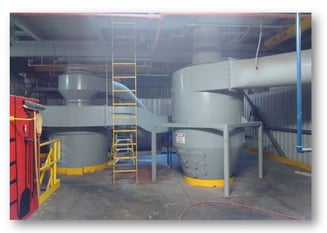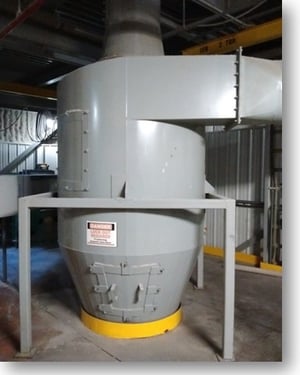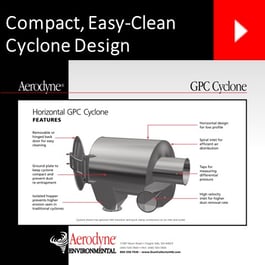 When sizing a cyclone dust collector, there are many factors that have to be reviewed in order to pick the best model for your applications. Some of them are:
When sizing a cyclone dust collector, there are many factors that have to be reviewed in order to pick the best model for your applications. Some of them are:
Airflow
What is the airflow going through the cyclone? The cyclone size is directly tied to the amount of air going through it. The more air there is, the larger the cyclone required. Without a doubt, this is the most important requirement for sizing a cyclone.
Temperature & pressure
The airflow volume is based on the temperature and pressure by the ideal gas law. The cyclone need to be sized based on ACFM (actual). Often times, customers provide SCFM (standard), which is the airflow when the temperature and pressure is 70°F and 1 atmosphere. If SCFM is provided, then it needs to be converted to ACFM for the correct cyclone to be selected. If not, the cyclone might be undersized, thereby increasing the pressure drop in the cyclone significantly, which can cause airflow issues.
Dust
The actual dust being collected also affects the cyclone selection. Is the dust explosive? What removal efficiency do you require? What is the dust’s physical characteristics, such as does it bridge, is it sticky, is it abrasive? All-of-these can affect the design of the cyclone. Example, a dust that bridges might have a special hopper to help prevent bridging.
Location
The location where the cyclone will be installed has a great influence on the cyclone selection. Is it located indoors or outdoors? How much space is available? Is there a height restriction? Will a vertical cyclone fit or must a horizontal cyclone be used. Is the cyclone being used as a pre-filter or is it the final dust collection equipment? 
Fan
If this isn’t a new application, the static pressure the fan has available is extremely important. The fan must have enough static pressure to overcome the pressure drop of the cyclone without decreasing the airflow through the system. This may require modifying the fan, replacing the fan or installing a larger cyclone.
Material of Construction
The cyclone must be constructed of the proper materials so it doesn’t rust or react with the material going through it. Often times the MOC will be carbon steel or a stainless steel. Special material of construction might be used, or a coating is applied (either internal or external) to extend the cyclone’s life.
Special considerations
There are additional things that may need to be considered when selecting the cyclone. Some examples include does it need to be cleaned often, so quick access is required? Are special welds, material finishing, etc. required?
These are some of the main considerations that are taken into account when a cyclone is sized for a dust collection system.
 The GPC Dust Collector is an efficient way to handle your dust collecting needs.
The GPC Dust Collector is an efficient way to handle your dust collecting needs.
Simply click the button below to find out more about the advantages and the specifications of the Aerodyne GPC Dust Collector.
To learn more about which dust collector, please contact our experts at 440-543-7400 or visit our website: www.dustcollectorhq.com.
To improve efficiency and safety, there is no substitute for an on-site inspection by an experienced expert. Click below to start with a free 20-minute phone consultation by clicking the button.


